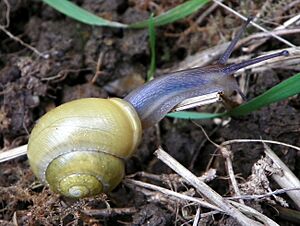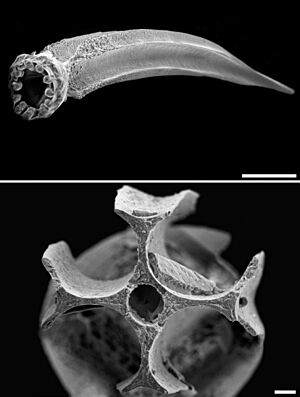White-lipped snail facts for kids
Quick facts for kids White-lipped snail |
|
|---|---|
 |
|
| Scientific classification |
The white-lipped snail, also known as the garden banded snail, is a type of land snail. Its scientific name is Cepaea hortensis. This snail breathes air and belongs to a group called molluscs. It is part of the Helicidae family. The only other snail like it in its group is the Cepaea nemoralis.
Contents
What Does a White-Lipped Snail Look Like?
The shell of a white-lipped snail can be up to 22 mm (about 0.87 inches) wide. It is usually a bit smaller than the shell of its cousin, C. nemoralis. When the snail is an adult, the small hole in the center of its shell (called the umbilicus) closes up. In young snails, it is still open.
Most C. hortensis shells are yellow. But they can also be brown, pink, or light yellow. They often have up to five brown stripes or bands. Sometimes, these bands can join together. Having many different shell colors and patterns is called polymorphism. Scientists have studied this a lot in these snails.
How to Identify a White-Lipped Snail
You can usually tell an adult white-lipped snail apart by the color of its shell's edge. This edge is called the lip around the opening. In C. hortensis, this lip is usually light-colored. In C. nemoralis, it is typically brown.
However, sometimes C. nemoralis can have a white lip. And rarely, C. hortensis might have a brown lip. To be sure, scientists sometimes need to look at the snail's internal parts. For example, the "love dart" of C. hortensis looks like a cross with split blades when cut open. The C. nemoralis love dart is a simple cross. Also, the mucus gland of C. hortensis has four or more branches. In C. nemoralis, it has three or fewer.
There are other snails that look similar, like Caucasotachea vindobonensis and Macularia sylvatica. These snails have a lip that is brown near the center but gets lighter towards the edge. Their shells also have fine ridges, while Cepaea snails have smooth shells.
Where White-Lipped Snails Live
White-lipped snails are originally from Western Europe and Central Europe. They are also found along the coast of northeastern North America. Scientists believe they have been there for at least 7,850 years. This means they were there even before the Vikings arrived.
C. hortensis lives further north in Scotland than C. nemoralis. It is the only Cepaea snail found in Iceland. It also lives in the northern parts of Scandinavia, as far north as 67° 30' N. On the other hand, its southern limit is further north too. In Spain, it is only found in the northeast. It is not found in Italy at all. Recently, C. hortensis was brought to the Moscow region of Russia and Ukraine. However, it has not spread as much there as C. nemoralis. These snails can live high up in the Swiss Alps, reaching altitudes of 2,050 meters (about 6,726 feet).
White-Lipped Snail Habitats
Both Cepaea snail species live in many of the same places. These include woods, sand dunes, and grassy areas. However, the white-lipped snail can handle wetter and colder places better.
White-Lipped Snail Life Cycle
This snail species uses special structures called love darts when they mate. These darts are part of their reproduction process. The eggs of the white-lipped snail are about 2 mm in size.



